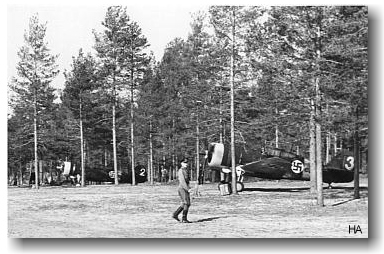CAMOUFLAGE & MARKINGS |
|
OF THE FINNISH AIR FORCE 1939 - 1945 |
CAMOUFLAGE & MARKINGS |
|
OF THE FINNISH AIR FORCE 1939 - 1945 |
.
 |
Curtiss
Hawk 75A fighters "Yellow 2" (CU-502, white
spinner) and "Blue 3" (with white edge) (CU-503,
red spinner) of Lentolaivue 32 (Le.Lv.32) (Flying
Squadron 32) at Nurmoila, Olonets, in the early summer
1942. "Blue 3" was releaved to squadron from
the State Aircraft Factory (VL) on 7.5.1942. Typical Finnish
markings - national insignias, large tail number, serial
number and yellow Eastern Front friendly plane markings -
are visible. The officer walking in the front could be
the Commander of Le.Lv.32 Major O. Ehrnrooth. |
.
National Insignia When Swedish Count Eric von Rosen flew the second forthcoming Finnish Air Force (FAF) aircraft - the donated Thulin typ D (licence-made Morane-Saulnier type L) - to Finland on 6.3.1918 he had his personal good luck emblem painted on wings: blue swastika on a white background. Since 18.3.1918 blue swastika emblem was officially adopted as Finnish national insignia and it has nothing to do with later similar kind of Nazi symbols usually painted in black. During a rather confusing period of 1918 -
1934 many versions of swastika were used before a new
basic type with lighter blue (FS 25123) swastika
on a white circle was adopted on 10.3.1934 (no
black line around circle). This version was used on every
FAF planes between 1934 and 1944. The maximum size
of the Finnish national insignia was reduced to 1 m on 23.7.1940
(Heinkel He 59B-2 plane HL-59 had much bigger
insignias on wings in summer 1943).
. After a series of tests in late 1943 a new subdued swastika was approved on 12.1.1944. The white roundel was simply toned down using officially light blue DN Colour (FS 25414) but in practice any available light grey or silver paint. Down toning was done at once to new planes and gradually to other planes when they were repaired or overhauled in State Aircraft Factory. Units also repainted the backgrounds of insignias and occasionally lower surface insignias were retained white. After the
Continuation War in autumn 1944 the Allied Supervision
Commission saw that the old Finnish national insignia
was too similar to Nazi swastika symbol. On 13.3.1945 a
new smaller (maximum diameter 66 cms) and more modern
roundel cockade insignia was adopted retroactively since
1.3.1945 with original basic colours - blue and white. Registration Serial Number All Finnish aircraft were marked with individual registration serial number usually painted in black but also other camouflage colours were used to make digits more clearly visible against camouflage paint. Font was Finnish Standard SFS Z.I.1 but aircraft serials painted in Sweden during the Winter War were of Swedish style. The size of the serial number was 50% of the height of the swastika on aircraft fuselage. Trainer aircraft had these normal or bigger and more visible serial numbers. Serial number consisted of two capital
letters indicating the aircraft model, hyphen and current
one to three digit number (for example DN-45, MT-201).
Types with two engine models could have smaller letter
digit added after the aircraft type letters indicating
engine model (for example CUw-556, w = Wright Cyclone
engine). All aircraft model codes are shown on the four
FAF aircraft pages. Aircraft Number In addition to registration serial number most Finnish aircraft had a very large number (or in a few cases a letter) painted either on a tail or a front fuselage (nose). The number was typically painted in one colour with or without lighter (usually white) edge but there were numbers with edges only. Several different font styles have also been used. During the Winter War numbers were usually very thin and from 1941 onwards much wider. Plane numbers were used in liaison and reconnaissance aircraft as well as in bombers but not so widely as with fighters. The colour of plane number indicated usually the flight together with spinner painting style or its colours. Le.Lv.32 (Flying Squadron 32) was exceptional because it had no planes named after pilot or even flight. Depending on flying squadron plane number was either the same as the last digit of the registration serial number or just a current number indicating aircraft's sequence in flight or squadron. During the
Continuation War one plane number was especially famous:
CWO O. Tuominen had number 0 (zero) painted on his
personal planes indicating his first name "Oiva".
There has been also other planes with number 0 not flown
by Tuominen. The use of this number was officially
forbidden but it was occasionally used until the end of
the Continuation War in September 1944. Eastern Front Markings June 1941 - September 1944 Before the Continuation War started on 18 June 1941 a new "friendly plane marking" (also known as "eastern front marking") was ordered to be painted to all Finnish combat aircraft by 22.6.1941. At first marking consisted of yellow (FS 13538) about 50 cms wide band around the rear fuselage and yellow lower surface wing tips usually halfway the national insignia (1/6 of the wing span). On bi-planes the yellow area could be also on lower surface of upper wings. The fuselage band was usually painted between the fin and national emblem but the exact location varied individually. Since 1.9.1941 an additional friendly marking for Finnish single engined planes only was 50 cms (radial engine) or initially 75 cms (later also 50 cms) (inline engine) wide yellow painting around the nose. On 13.6.1944 yellow paint was urgently removed from the upper half of the nose to diminish the visibility of the Finnish planes. Yellow eastern front markings were removed
from all Finnish planes within ten days after the truce
on 4.9.1944. [ Finnish Air Force Camouflage 1939 - 1945 ] . . |
![]()
© 2001 - 9.10.2004 Harri Anttonen
![]()